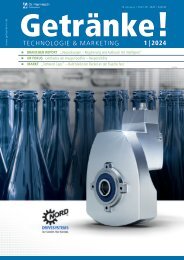GET – GREEN EFFICIENT TECHNOLOGIES – English Language
“GET – GREEN EFFICIENT TECHNOLOGIES” is the new independent media platform for energy supply, efficiency improvement and alternative energy sources and storage. There is still a high potential to save energy in industry. Efficiency is not only important for the profitability of a company, it is also target-oriented and saves resources. The importance of efficiency, especially in energy production, the role played by hydrogen, industrial processes, resource and recycling management, how energy can be stored and much more can be found in the new GET.
“GET – GREEN EFFICIENT TECHNOLOGIES” is the new independent media platform for energy supply, efficiency improvement and alternative energy sources and storage. There is still a high potential to save energy in industry. Efficiency is not only important for the profitability of a company, it is also target-oriented and saves resources. The importance of efficiency, especially in energy production, the role played by hydrogen, industrial processes, resource and recycling management, how energy can be stored and much more can be found in the new GET.
You also want an ePaper? Increase the reach of your titles
YUMPU automatically turns print PDFs into web optimized ePapers that Google loves.
Components<br />
Radar sensor<br />
Fig. 3: The conditions around the shaft furnace<br />
are harsh. However, the radar sensors<br />
are not impressed by dust or the high temperatures.<br />
ler makes things significantly easier.<br />
With NAMUR electronics, not only is<br />
very simple wiring possible, but also<br />
the test of the sensor via the test key<br />
on the control unit in the control cabinet.<br />
It is therefore no longer necessary<br />
to climb up to the top of the vessel;<br />
dismounting the instruments for<br />
testing is also a thing of the past. This<br />
in turn saves a lot of time and increases<br />
the safety of personnel. The level<br />
switch detects limit levels in the vessel<br />
and forwards them to the controller.<br />
The measured value is adapted to<br />
the specific conditions of the measuring<br />
point through an adjustment in<br />
the controller. Readings are shown on<br />
the display and outputted via the integrated<br />
current outputs. This means<br />
that the point level signals can also be<br />
used for simple control tasks. What is<br />
more, the signal circuit is monitored<br />
for line interruption and short-circuit.<br />
Monitoring the level in the<br />
shaft furnace<br />
A very special place of application<br />
for continuous level measurement is<br />
the shaft furnace. Packages of scrap<br />
are fed into this furnace via a conveyor.<br />
Beside the high ambient temperatures,<br />
the process heat itself<br />
as well as dust and vibration constantly<br />
create new challenges for the<br />
deployed measurement technology.<br />
Until December 2021, a radiometric<br />
measuring system for min/max monitoring<br />
was used at this site, but it did<br />
not deliver reliable readings. And this<br />
method was very limited in scope<br />
<strong>–</strong> it only allowed point level detection.<br />
For this reason, and because of<br />
the ever-present danger of the radiation<br />
source, the company wanted to<br />
replace it with something better.<br />
“We have to monitor the level<br />
precisely in order to maintain the<br />
optimal filling volume,” explains the<br />
Head of Electrical Engineering further.<br />
A steady inflow of product mix<br />
is extremely important for the entire<br />
process. The special situation: There<br />
must always be product in the combustion<br />
chamber, otherwise the fire<br />
could flash back and cause great<br />
damage. Here, continuous measurement<br />
with VEGA sensors makes it<br />
possible to feed in the scrap packages<br />
evenly. He goes on to emphasize this<br />
point: “Before this measuring system<br />
was installed, the shaft furnace was<br />
repeatedly emptied too much and it<br />
was damaged as a result of the excessive<br />
temperatures.”<br />
Now, the radar sensor keeps the<br />
level in the shaft furnace exactly at<br />
the optimal point. With the help of a<br />
45° mirror, the level inside the shaft<br />
furnace is measured by the externally<br />
mounted, and thus well protected,<br />
radar sensor. The sensor was installed<br />
and commissioned by the Head<br />
of Electrical Engineering and his team<br />
at the end of December 2021. Fine<br />
adjustment was carried out by a VEGA<br />
engineer.<br />
The radar sensor is hardly<br />
affected by the harsh conditions, even<br />
the deposits on the shaft walls do not<br />
interfere with the measurement. This<br />
is due to the sensor’s very small beam<br />
angle of 4°. As a result, the sensor can<br />
be used reliably even in narrow shafts<br />
with internal installations or buildup<br />
on the walls, because the measuring<br />
beam simply travels right past such<br />
obstacles.<br />
Eliminating false signals<br />
Two aspects played a role in selecting<br />
the sensor. The first: The radar sensor<br />
can cope with extremely high temperatures.<br />
The process temperature<br />
inside the furnace is approx. 200 °C<br />
and the ambient temperature outside<br />
the furnace, approx. 50 °C, is still<br />
quite hot. And the second: The sensor<br />
is optimised for measurement at<br />
close range. Special processing of the<br />
reflections in the close range makes<br />
it possible to reduce the influence of<br />
interference signals directly in front of<br />
the antenna system. The tight focusing<br />
of the transmitted signal offers<br />
further advantages. The most important<br />
is that the actual measurement<br />
signal can be separated quite well<br />
from interference signals, allowing<br />
even the smallest reflected signals to<br />
be picked up. And last but not least,<br />
the sensor is non-sensitive to buildup<br />
on its own surfaces <strong>–</strong> extremely<br />
important in the harsh environment<br />
of the furnace.<br />
Beside the advantages in the process<br />
Fig. 4: With the aid of a 45 degree mirror the<br />
filling level in the shaft furnace is measured.<br />
and the high measurement accuracy,<br />
there were also very practical considerations<br />
that convinced the Head<br />
of Electrical Engineering from the<br />
Tyrolean company and his engineering<br />
team that VEGA technology was<br />
the right choice. These included the<br />
simple installation and maintenance,<br />
the price and the customer service.<br />
The sensors can also be conveniently<br />
adjusted via a smartphone with<br />
Bluetooth, which makes them ideal<br />
for harsh environments, Ex areas or<br />
measuring points that are difficult to<br />
access. Thanks to Bluetooth and the<br />
intuitive adjustment structure, the<br />
team was able to install the radar<br />
sensor in the shaft furnace and get<br />
it up and running in no time. What is<br />
more, they can now instantly retrieve<br />
all relevant information about the<br />
instrument just by entering its serial<br />
number. This greatly facilitates maintenance<br />
work carried out later.<br />
VEGA Grieshaber KG,<br />
Schiltach, Germany<br />
<strong>GREEN</strong> <strong>EFFICIENT</strong> <strong>TECHNOLOGIES</strong> 2022<br />
37


















